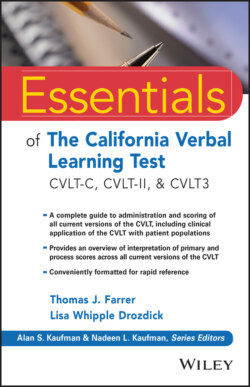Читать книгу Essentials of the California Verbal Learning Test - Thomas J. Farrer - Страница 7
HISTORY AND DEVELOPMENT
ОглавлениеAlthough the concept of investigating the processes underlying memory is standard in memory assessment instruments today, at the time the original CVLT (Delis, Kramer, Kaplan, & Ober, 1987) was developed in 1987 it was a novel approach to assessment. The authors combined research and clinical experience with patients with memory deficits to create a novel approach to assessing learning and memory processes. Memory deficits were linked to specific tasks within a 16-word memory recall and recognition test. The 16 words were derived from four semantic categories, allowing the examinee to group words semantically as an aid to recalling the words. This approach allows examination of not only how much an individual can learn and retain but also the strategies used to learn and recall information and the types of memory errors made. These additional measures provide detailed information on the processes involved in learning and memory to aid in diagnosis and intervention planning.
In the original CVLT, the examiner read a Monday shopping list that contained 16 items to the examinee. The 16 items consisted of four words from four different semantic categories (tools, fruit, clothing, spices, and herbs). The Monday shopping list was repeated in five learning trials, followed by an interference list trial. A Tuesday shopping interference list also comprised 16 words from four categories. Two of the categories overlapped with categories from the Monday list and two were novel categories. Following recall of the Tuesday list, the examinee was asked to recall the Monday list in both a free-recall and a cued-recall trial. During the cued-recall trial, the examiner provided each of the four semantic categories and asked the examinee to name the items from each. The examiner than waited 20 min before administering delayed free- and cued-recall trials, as well as a delayed recognition trial (see Figure 1.1). The examiner was encouraged to administer nonverbal tasks during this 20-min delay. Scores derived on the CVLT assessed attention, learning strategies, recall accuracy, interference effects, recall errors, and recognition. The original normative sample consisted of 273 neurologically intact individuals (104 males, 169 females) recruited from other research studies being conducted at the time of data collection.
Since 1987, three revisions and expansions of the CVLT have been published, although the administration has remained remarkably stable. The expansion and evolution of the CVLT reflect the growing influence and use of the process approach to memory assessment. Its wide use in research on memory also ensures several editions of the CVLT will remain in use for a long time. The currently available editions include the CVLT3 (published in 2017), the CVLT-II (published in 2000), and the CVLT-C (published in 1994). Each of the editions reflects the knowledge and theories of memory at the time of its development as well as the developmental needs of the population assessed. This chapter provides an overview of the content of each of the currently available CVLT instruments, and later chapters provide a review of the research literature related to memory and learning as measured by the CVLT.
| Learning trials | Interference trial | Short-delay | Long-delay (follows 20-min delay) | Yes/No recognition | Forced-choice recognition (follows 10-min delay)a |
| Trial 1 Free RecallTrial 2 Free RecallTrial 3 Free RecallTrial 4 Free RecallTrial 5 Free Recall | List B Free Recall | Short-Delay Free RecallShort-Delay Cued Recall | Long-Delay Free RecallLong-Delay Cued Recall | Yes/No Recognition | Forced-Choice Recognition |
| a Only on CVLT-II and CVLT3. |
Figure 1.1 CVLT-C, CVLT-II standard and alternate, and CVLT3 standard and alternate forms structure.
